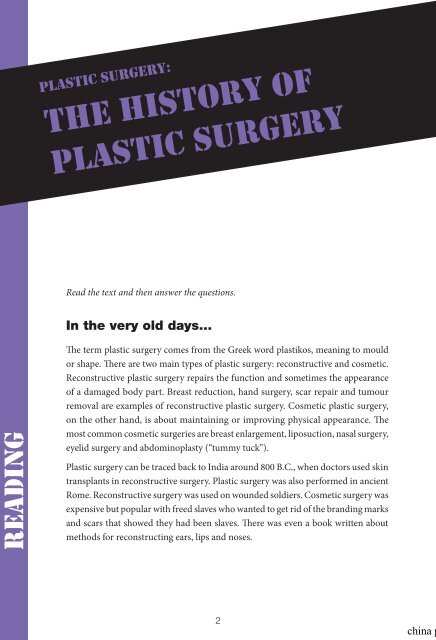plastic surgery - Duegemelle
plastic surgery - Duegemelle
plastic surgery - Duegemelle
Create successful ePaper yourself
Turn your PDF publications into a flip-book with our unique Google optimized e-Paper software.
eaDiNg<br />
<strong>plastic</strong> <strong>surgery</strong>:<br />
the history of<br />
<strong>plastic</strong> <strong>surgery</strong><br />
Read the text and then answer the questions.<br />
In the very old days...<br />
The term <strong>plastic</strong> <strong>surgery</strong> comes from the Greek word plastikos, meaning to mould<br />
or shape. There are two main types of <strong>plastic</strong> <strong>surgery</strong>: reconstructive and cosmetic.<br />
Reconstructive <strong>plastic</strong> <strong>surgery</strong> repairs the function and sometimes the appearance<br />
of a damaged body part. Breast reduction, hand <strong>surgery</strong>, scar repair and tumour<br />
removal are examples of reconstructive <strong>plastic</strong> <strong>surgery</strong>. Cosmetic <strong>plastic</strong> <strong>surgery</strong>,<br />
on the other hand, is about maintaining or improving physical appearance. The<br />
most common cosmetic surgeries are breast enlargement, liposuction, nasal <strong>surgery</strong>,<br />
eyelid <strong>surgery</strong> and abdominoplasty (“tummy tuck”).<br />
Plastic <strong>surgery</strong> can be traced back to India around 800 B.C., when doctors used skin<br />
transplants in reconstructive <strong>surgery</strong>. Plastic <strong>surgery</strong> was also performed in ancient<br />
Rome. Reconstructive <strong>surgery</strong> was used on wounded soldiers. Cosmetic <strong>surgery</strong> was<br />
expensive but popular with freed slaves who wanted to get rid of the branding marks<br />
and scars that showed they had been slaves. There was even a book written about<br />
methods for reconstructing ears, lips and noses.<br />
There were no more major developments over the following<br />
centuries. In 1460, Heinrich von Pfolspeundt published a book<br />
with a description of how to reconstruct noses. This involved<br />
taking skin from the patient’s forearm, sewing it onto the nose,<br />
and then binding the raised arm to the nose for up to ten days to<br />
keep it in place. During the Renaissance, techniques developed<br />
further for nose and jaw reconstruction, eyelid <strong>surgery</strong> and breast<br />
reduction.<br />
Wars and wounds<br />
After another quiet period, reconstructive <strong>surgery</strong> reappeared<br />
in Europe at the end of the eighteenth century with a series of<br />
successful nasal reconstructions. The term <strong>plastic</strong> <strong>surgery</strong> was<br />
used for the first time by a German surgeon, Carl von Graefe,<br />
in 1818. However, the breakthrough for <strong>plastic</strong> <strong>surgery</strong> as a<br />
recognized medical discipline came with the First World War. The<br />
war was the first to use large amounts of long-range artillery and<br />
explosives. As a result, many soldiers suffered terrible injuries.<br />
Facial wounds were common, which meant that military surgeons<br />
were given plenty of material to practice on.<br />
2 3<br />
china <strong>plastic</strong><br />
abdominoplasty bukplastik<br />
appearance utseende<br />
branding mark<br />
brännmärkning<br />
breakthrough genombrott<br />
common vanlig<br />
damage skada<br />
development utveckling,<br />
framsteg<br />
discipline vetenskapligt<br />
ämne, disciplin<br />
facial ansiktsinjury<br />
skada<br />
jaw haka<br />
long-range artillery<br />
långdistansartilleri<br />
maintain bibehålla, underhålla<br />
mould gjuta, forma<br />
nasal nasal, näsperform<br />
utföra<br />
reappear komma tillbaka<br />
recognized erkänd, igenkänd<br />
reconstructive<br />
återuppbyggande<br />
reduction förminskning<br />
removal borttagning<br />
repair reparera<br />
scar ärr<br />
sew sy<br />
surgeon kirurg<br />
trace spåra<br />
wounded skadad


